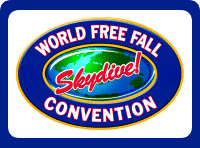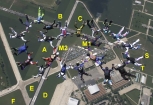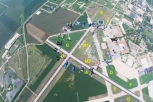

HOME
FAQ
2006 Aircraft
Convention
Calendar
Competition
Facilities/Maps
Gear & Jumper Requirements
Links
Load Organizers
Message Board
Non-Jumpers
Photo's from 2005
Reviews of past WFFC's
Safety Info
Spectators
Sponsorship
Student / Tandem
Travel Info
Vendor/DZ Row Application
Vendors
Volunteers
WebCam
What's New
Contact Us
|
|
 |
 |
 |
 |
Important Safety Information For Skydivers at the WFFC
The following pictures show the city of Rantoul, the airport, and the Convention site.
For more detailed views, see the maps on the facilities page.
Aircraft loading and exit
The aircraft staff at the loading tents are an important source
of information. They can provide you with the direction of the
jump run, winds aloft information, the time between exits of groups
on the same aircraft, and any information particular to the type
of aircraft you will be jumping.
Loading and Exit Order:
Pay attention to the aircraft loader and approach the aircraft
only from the direction indicated by the loader! Do not let your
excitement or haste cause you to forget basic aircraft loading
safety. (Propellers!) If there are any non-skydivers in the area
who are not supervised, please watch out for them.
The direction of the upper winds may require that Tandems
exit first, so please be flexible and cooperate with the
Tandem Instructors if they have a request. Otherwise the
exit order will probably be flat flying groups from larger
to smaller, then fast fall rate groups from larger to smaller.
Exit:
Spotting is done by the aircraft staff and they are very good
at it. Do not second-guess them! Exit lights or other obvious
methods are provided to tell you when to exit, so do not delay.
Go to the door, give the count, and leave. The aircraft staff
and other groups of skydivers behind you are counting on your
ability to do this.
Pay particular attention to the weight and balance issues with
the aircraft. Do not place more jumpers to the rear of the
aircraft than permitted. If you are in the later groups exiting,
stay as far forward as possible.
Opening Altitude
At the Convention there will be multiple aircraft dropping
loads of jumpers over the same areas at short intervals.
In order to insure that jumpers from an earlier load have
descended below the opening area for the later load, you
must not open high!
You need to plan your deployment altitude so that you have a
fully open canopy no higher than 3000 feet AGL, and you are
expected to be familiar with the opening characteristics of the
canopy you will jumping in order to do this.
If you are jumping a demo canopy, you should consult the
supplier of the canopy for advice on its opening characteristics.
If you experience a premature deployment or other situation that
places you above 3000 feet under canopy, you must either quickly
descend below 3000 feet or fly your canopy away from the jump run
in order to provide clear airspace for the later jumpers.
WFFC landing areas
The Rantoul, IL airport is very large and has numerous areas in which
skydivers can land their canopies. You are not required to land in
the "Main" landing area! Refer to these photos that have the various
landing areas identified.
LandingAreaLowAltitude  LandingAreaHighAltitude LandingAreaHighAltitude 
- M1 - Main landing area where many jumpers land. Can be congested
during peak jumping times, but will be wide open on the early morning
loads.
- M2 - Secondary landing area. Used when the prevailing winds are
stronger and it makes more sense to land in one of the directions
that favors this area. Also prefered by those who want to land close
but want a less crowded landing area.
- S - Student (AFF) landing area. Experienced jumpers are welcome, but
must yield to students.
- T -Tandem (and "demo") area. Experienced jumpers are welcome to
entertain the spectators, but must yield to Tandem skydivers.
- A through G - Alternate landing areas. Some of these are almost
completely unused. (Landing across any of the active runways requires
waiting for Staff escort across the runway, which will mean a short
delay.)
Hook Turns:
Hook turns (turns more than 90 degrees to landing) are permitted
only in the swoop pond hook turn area!!! Hook turns are extremely
dangerous at the Convention and must not be done where they are not
expected.
Wind Indicators:
There will be a large number of wind indicators at the Convention
site, but they may not be the type that you are used to seeing.
Many manufacturers have Windblades, and many skydivers have their
own favorite wind socks and streamers. The normal airport wind
socks are also present. Make sure to look for all of these
indicators well in advance of landing. Notice: Wind indicators
near the aircraft loading areas will be temporarily affected
by departing aircraft!
Landing pattern:
The left hand landing pattern has become the standard in
skydiving with few exceptions. On most jumps you will be
opening in an area that easily permits a left hand landing
pattern, so please think ahead, plan your landing pattern,
and try to fit into the pattern well with other jumpers.
If you open in an area that does not allow a left hand
pattern, then change your landing area!
Right-of-way:
Another safety standard on landing is to give the lower canopy
the right of way, because you can see them but they cannot usually
see you. If you have a small canopy and descend below another
canopy not descending as quickly, you must be very careful because
this will suddenly change which canopy has the right-of-way. You
must also not do this in order to gain the right-of-way, nor to
expect it.
No-Wind Conditions:
Light and variable wind conditions can present some dangerous
landing conditions at the Convention because the wind indicators
may be changing, even while a load is descending. This causes
some jumpers to be confused about the landing direction and to
land in different directions. The best bet is to fit into a
pattern with the jumpers landing before you, even if this makes
your landing slightly downwind. If the winds are variable they
will surely be light, and a downwind landing at those wind
speeds should not be cause for concern. Concentrate on the landing
and run it out. If you have any doubts about the landing pattern
or direction, please land in an alternate or very open landing area,
and use extreme caution.
|

|
 |
 |
 |
|



